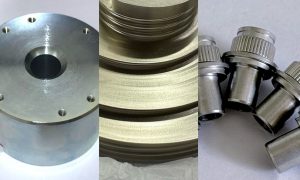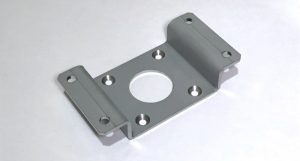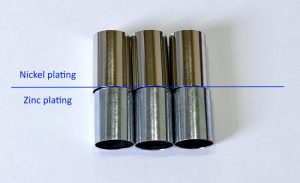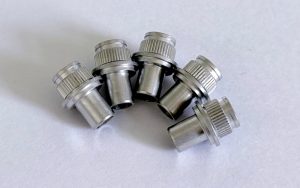
The electroplating process is widely used in industrial design. It forms different metal film layers on the surface of metal objects through the principle of electrolysis to provide various functional properties, such as preventing oxidation and rust, improving wear resistance, light reflectivity, conductivity, corrosion resistance, and enhancing aesthetics.
The three most commonly used electroplating processes in mechanical manufacturing are zinc plating, nickel plating, and chrome plating. So, what are the differences between these three?
Zinc Plating
Zinc plating is primarily used to prevent rust on steel products and is especially effective for iron-based materials. Its biggest advantage is low cost—making it the cheapest of the three—although its surface appearance is less refined compared to nickel and chrome plating. Standard zinc plating appears silver-white with a bluish tint, but other color options are available (white, blue, black, yellow).

Galvanized steel sheets and hot-dip galvanized sheets—often used in stamping—offer stronger rust resistance and longer service life compared to ordinary steel, making them more suitable for outdoor environments. Additionally, forged screws are often galvanized for protection.

Nickel Plating
Nickel plating typically appears bright white or silvery white with a yellowish tint, though black nickel is also available. It is both wear-resistant and corrosion-resistant and is commonly used for decorative applications, such as lamp holders, coins, and other consumer products. Depending on color and function, nickel plating can be classified as bright (full or semi-gloss), satin (matte), etc.
There are two common types of nickel plating processes: electroplated nickel and chemical nickel plating (also known as electroless nickel plating).
Electroplated Nickel
This method uses electrolysis to deposit nickel on the surface. Since the plating depends on electric current distribution, the uniformity of the coating can be affected by the shape of the workpiece.
Electroplated nickel is widely used in electronics, accessories, and household appliances due to its glossy finish and decorative appeal. Its hardness and wear resistance also make it suitable for mechanical components.
Chemical Nickel Plating
This is a self-catalytic chemical reaction that does not require an external current. It uses a reducing agent to deposit a uniform nickel layer onto the surface. Because it does not rely on current, it can coat workpieces with complex shapes more evenly.
Chemical nickel plating is favored in aerospace, automotive, and chemical equipment industries for its superior corrosion resistance and uniform coverage, especially where precision and durability are essential.

Chrome Plating
Chrome plating typically presents a cold white appearance, although black chrome is also available. Like nickel plating, it can have various finishes: bright (full or semi-gloss) or satin (matte).
Chrome plating is generally divided into two categories based on function: decorative chrome plating and functional (hard) chrome plating.
Decorative Chrome Plating
Enhances appearance, reduces rust, and improves wear resistance. However, its corrosion resistance is slightly inferior. It’s commonly used on decorative components and faucets in home appliances and electronics.
Functional Chrome Plating
Focuses on enhancing surface hardness and wear resistance. It’s widely applied to industrial and mechanical parts exposed to heavy wear, with thicker coatings. Examples include engine parts and machine tools, where durability is critical.
Among the three types, chrome plating is the most expensive, followed by nickel plating, with zinc plating being the most economical.
Electroplating is an essential process in industrial design that enhances both the functionality and appearance of metal parts by adding a surface layer of metal or alloy. Choosing the right electroplating method depends on specific requirements. Whether your goal is aesthetics, corrosion resistance, or wear resistance, these processes offer reliable and effective solutions across various industries.
You can find the photo display of the CNC machining parts made by us HERE!
